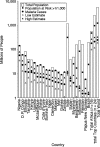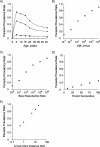Uncertainty in mapping malaria epidemiology: implications for control
- PMID: 20581219
- PMCID: PMC2912605
- DOI: 10.1093/epirev/mxq013
Uncertainty in mapping malaria epidemiology: implications for control
Abstract
Malaria is a location-specific, dynamic infectious disease transmitted by mosquitoes to humans and is influenced by environmental, vector, parasite, and host factors. The principal purposes of malarial epidemiology are 1) to describe the malarial distribution in space and time along with the physical, biologic, and social etiologic factors and 2) to guide control objectives for either modeling impact or measuring progress of control tactics. Mapping malaria and many of its causative factors has been achieved on many different levels from global distribution to biologic quantitative trait localization in humans, parasites, and mosquitoes. Despite these important achievements, a large degree of uncertainty still exists on the annual burden of malarial cases. Accurate, sensitive detection and treatment of asymptomatic reservoirs important to infectious transmission are additional components necessary for future control measures. Presently spurred by the leadership and funding of Bill and Melinda Gates, the malarial community is developing and implementing plans for elimination of malaria. The challenge for malariologists is to digitally integrate and map epidemiologic factors and intervention measures in space and time to target effective, sustainable control alongside research efforts.
Figures


References
-
- Joy DA, Feng X, Mu J, et al. Early origin and recent expansion of Plasmodium falciparum. Science. 2003;300(5617):318–321. - PubMed
-
- Volkman SK, Barry AE, Lyons EJ, et al. Recent origin of Plasmodium falciparum from a single progenitor. Science. 2001;293(5529):482–484. - PubMed
-
- Mu J, Duan J, Makova KD, et al. Chromosome-wide SNPs reveal an ancient origin for Plasmodium falciparum. Nature. 2002;418(6895):323–326. - PubMed
-
- Laveran A. Un nouveau parasite trouve dans le sang des malade atteints de fievre palustre. Origine parasitaire des accidents de l'impaludisme. (In French) Bull Acad Natl Med Paris. 1880;9:1235–1236.
-
- Laveran CL. Classics in infectious diseases: a newly discovered parasite in the blood of patients suffering from malaria. Parasitic etiology of attacks of malaria: Charles Louis Alphonse Laveran (1845–1922) Rev Infect Dis. 1982;4(4):908–911. - PubMed

